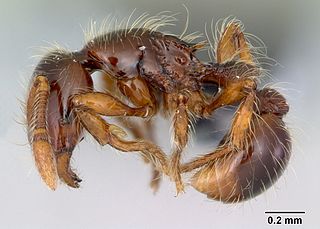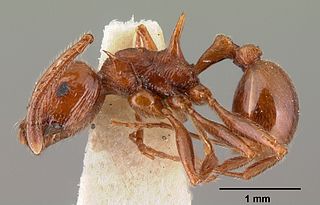
Myrmica is a genus of ants within the subfamily Myrmicinae. It is widespread throughout the temperate regions of the Holarctic and high mountains in Southeast Asia.
Barry Bolton is an English myrmecologist, an expert on the classification, systematics, and taxonomy of ants, who long worked at the Natural History Museum, London. He is known especially for monographs on African and Asian ants, and for encyclopaedic global works, including the Identification Guide to Ant Genera (1994), A New General Catalogue of Ants of the World, Synopsis and Classification of Formicidae (2003), and Bolton's Catalogue of Ants of the World: 1758-2005 (2007). Now retired, Bolton is a Fellow of the Royal Entomological Society and Myrmecologist, Biodiversity Division, Department of Entomology, Natural History Museum, London.

Plagiolepis is an ant genus of the formic acid-producing subfamily Formicinae. The genus is found in tropical and temperate regions of the Old World.

Leptanilla is a genus of ant in the subfamily Leptanillinae. Like other genera in this subfamily, the queen is fed by the hemolymph of their own larvae, which have specialized processes for this purpose.

Anochetus is a genus of small, carnivorous ants found in the tropics and subtropics throughout the world.

Anochetus boltoni is a species of ant in the genus Anochetus. It was discovered in 2003 by B. L. Fisher in Madagascar and described by Fisher, B. L. & Smith, M. A. in 2008.

Stigmatomma is a genus of ants in the subfamily Amblyoponinae. The genus has a worldwide distribution, and like most other amblyoponines, Stigmatomma species are specialized predators. First described by Roger (1859), it was for a long time considered to be a synonym of Amblyopone until it was revived as an independent genus by Yoshimura & Fisher (2012) based on worker mandible morphology.

Proceratium is a rare genus of ants in the subfamily Proceratiinae. It is the type genus of the tribe Proceratiini, which in addition to Proceratium consists of two even rarer genera: the extant Discothyrea and the fossil genus Bradoponera.

Anomalomyrma is an Asian genus of ants in the subfamily Leptanillinae. The genus was originally described in 1990 with the type species Anomalomyrma taylori, based on a single dealate queen from Borneo. Workers were unknown until 2011, when two new species were described from Peninsular Malaysia and the Philippines.

Cryptomyrmex is a genus of ant in the subfamily Myrmicinae. The genus is known from Brazil and Paraguay.

Cataulacus is a genus of ants in the subfamily Myrmicinae. The genus is distributed in the Paleotropical regions, mainly in the Afrotropics. Most species are found in forests, but a few are known from more open and arid habitats.

Chimaeridris is a small genus of ants in the subfamily Myrmicinae. The genus contains two species known from tropical Asia. Their unique hook-shaped mandibles and similar appearance to Pheidole minor workers raises the possibility that the genus is a slave-maker of Pheidole ants or a specialized predator.

Pristomyrmex is a genus of ants in the subfamily Myrmicinae.

Nylanderia is a large genus of ants in the subfamily Formicinae. The genus has a nearly cosmopolitan distribution with species inhabiting a wide array of habitats in almost all geographic regions. Nylanderia, currently containing over 110 species, is an ecologically important genus, with some species reported as being invasive. The ants are small to medium in size and range in color from pale yellow to black.

Meranoplus is an Old World genus of ants in the subfamily Myrmicinae. With over 80 valid species, it is predicted that over half of the Meranoplus diversity remains undescribed, most of these from Australia.
Daceton boltoni is a Neotropical species of arboreal ants in the subfamily Myrmicinae. The species occurs in Peru and Brazil and is similar to its sister species, D. armigerum.
Meranoplus boltoni is a species of ant of the subfamily Myrmicinae. It is found in Sri Lanka.
Anticostiodus is an extinct genus of multielement conodonts. Specimens have been described from the Lower Silurian of Gun River Formation of Anticosti Island, Quebec. Two species are included under the genus, Anticostiodus fahraeusi and Anticostiodus boltoni. Both species occur near the base of the Distomodus staurognathoides zone and in an open subtidal environment.
Monomorium boltoni is a species of insects of the family Formicidae, the ants. The species is endemic to Cape Verde, where it is restricted to the island of São Nicolau. The species was first described in 1987.

Leioproctus boltoni is a species of bee in the family of plasterer bees. This species was first described in 1904 and is endemic to New Zealand. They are a solitary bee, small and black in appearance. L. boltoni can be found throughout the main islands of New Zealand and forages on the flowers of both native and introduced species of plants. This species nests in the soil with their life cycle lasting approximately a year.















